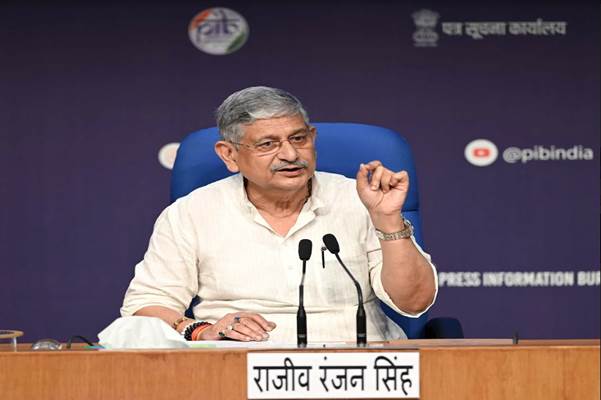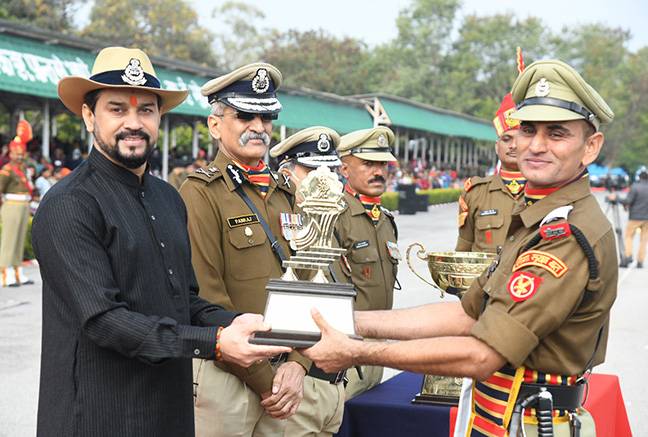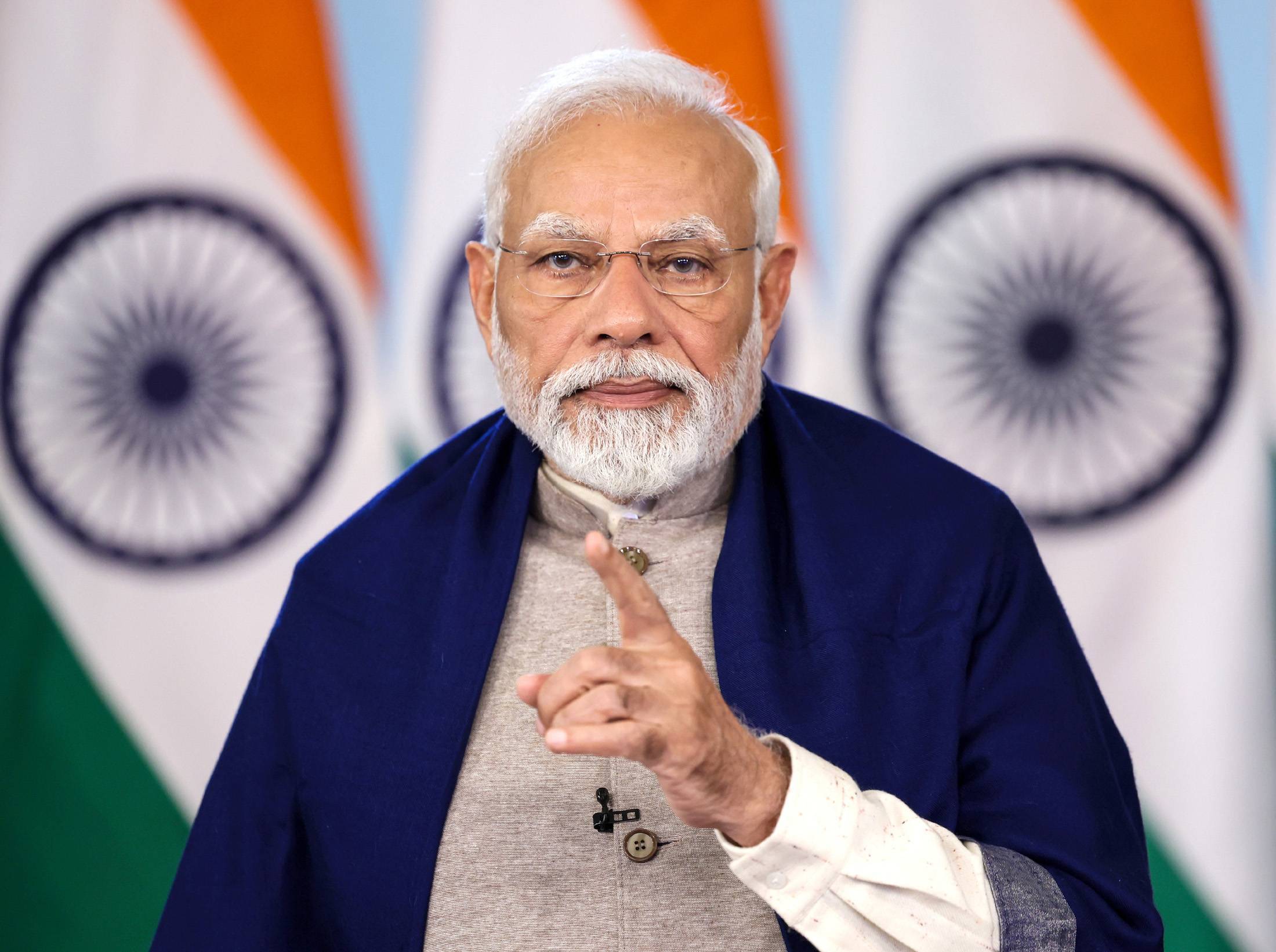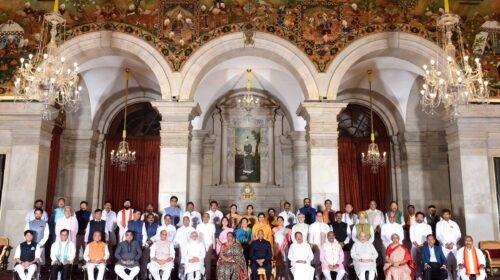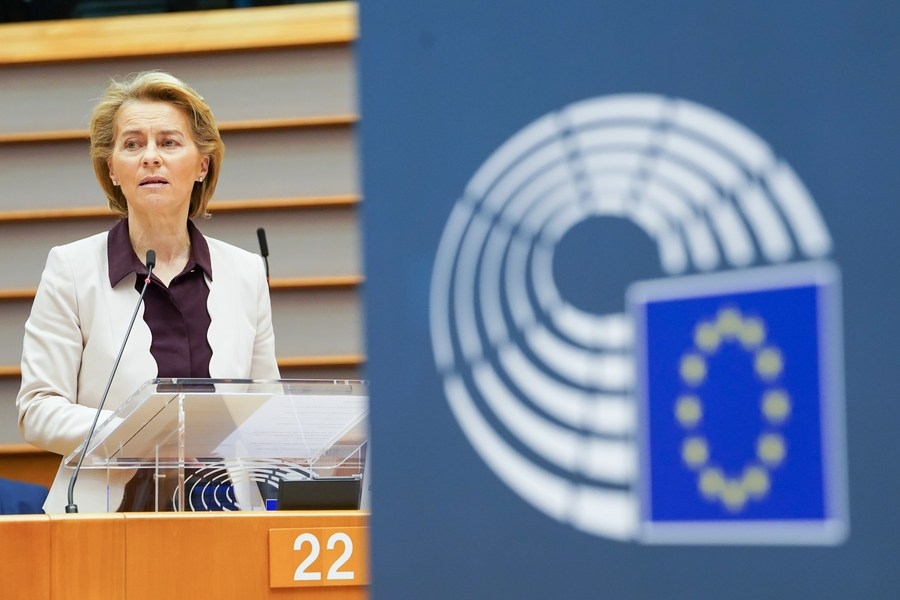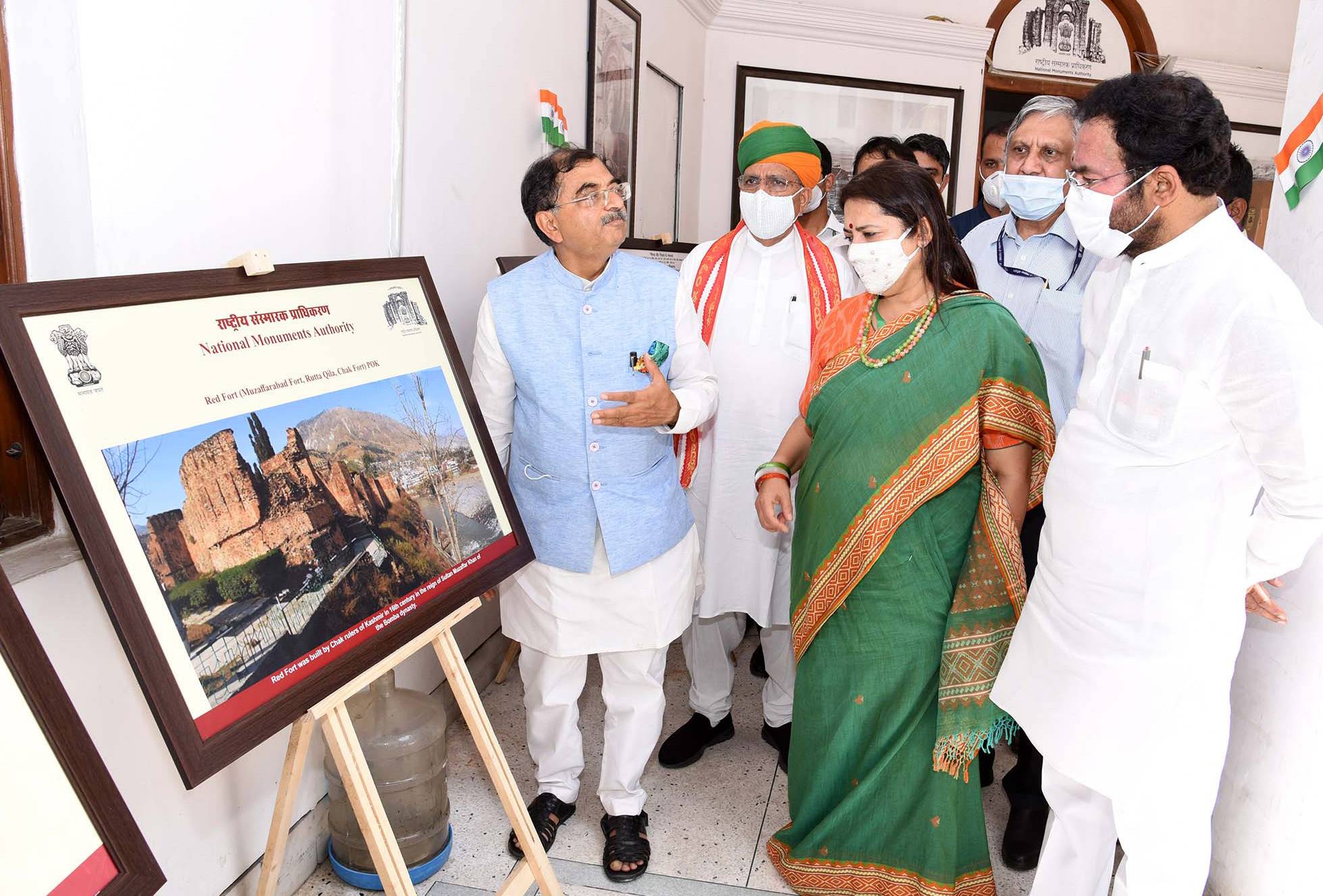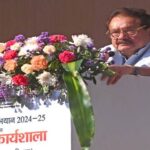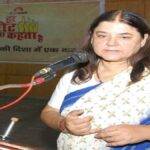Achievements of Fisheries Department:
While briefing Achievements of Fisheries Department, Union Minister Shri Rajiv Ranjan Singh said that Fisheries and aquaculture are an important source of food, nutrition, employment, income and foreign exchange. Fish being an affordable and rich source of healthy animal protein and omega 3-fatty acids, it offers immense potential to mitigate hunger and malnutrition.
Union Minister Shri Rajiv Ranjan Singh said that India is blessed with rich and diverse fisheries resources and a variety of fish species are found that enrich our biodiversity. Fisheries and aquaculture is a promising sector that provides livelihood and employment opportunities to about 3 crore fishers and fish farmers at the primary level and several lakhs along the value chain. India is the 2nd largest fish producing country with around 8% share in global fish production. Globally, India also stands at 2nd in aquaculture production, is one of the top shrimp producing and exporting nations and 3rd largest capture fisheries producer. During last ten years, the Government of India has taken up several transformational initiatives for holistic development of fisheries and aquaculture sector. Some of the key reforms are highlighted below.
Creation of New Department of Fisheries and Ministry for Fisheries, Animal Husbandry and Dairying: Recognizing the immense potential of the Fisheries Sector and for focused and holistic development of the sector with fishers and fish farmers’ welfare at the core, the Government of India created a separate Department of Fisheries in February, 2019 and this was followed up by creation of a new Ministry of Fisheries, Animal Husbandry and Dairying in June, 2019.
Highest ever investments in fisheries sector: During last 10 years, the Government of India has stepped up investments in fisheries and aquaculture sector. From 2015, the central government has approved schemes namely Blue Revolution Scheme, Fisheries and Aquaculture Infrastructure Development Fund (FIDF), Pradhan Mantri Matsya Sampada Yojana and Pradhan Mantri Matsya Samridhi Sah Yojana (PMMMKSSY), a sub-scheme under PMMSY with total investments of Rs 38,572 crore.
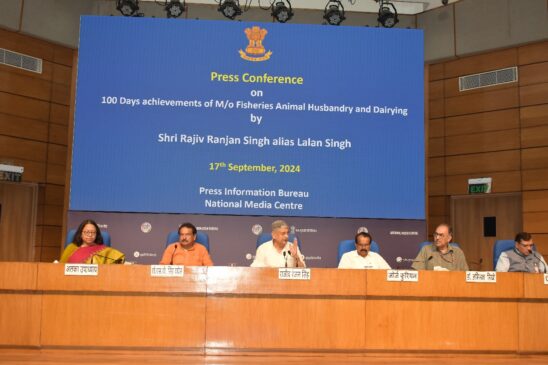
The Flagship Scheme Pradhan Mantri Matsya Sampada Yojana (PMMSY) is under implementation since FY 2020-21, with investment target of Rs.20,050 crore and is the highest ever investment in Fisheries and Aquaculture Sector in the country. Projects worth of Rs 20,687.28 crore have been approved under PMMSY during the last four years from FY 2020-21 to 2023-24 for the States/UTs and other implementing agencies, thus 100% of the envisaged investment projects has been approved under PMMSY within four years of its implementation.
Record National Fish Production: Fisheries Sector commenced purely as a traditional activity at the time of India’s Independence. Over the past seventy-five years, the sector has gradually transformed into a commercial enterprise while maintaining its traditional and small-scale character. The fish production in the country rose from 7.52 lakh tonnein 1950-51 to an all-time record of 175.45 lakh tons in 2022-23, which is more than 23-fold increase in national fish production. During the last 9 years, the annual fish production of India has increased from 95.79 lakh tons (at the end of FY 2013-14) to record production of 175.45 lakh tons (at the end of FY 2022-23) i.e. an increase of 79.66 lakh tons i.e. more than 83%
Doubling of Inland and Aquaculture Production: Fish production from inland fisheries and aquaculture increased from mere 2.18 lakh tons in FY 1950-51 to 131.33 lakh tons in FY 2022-23. The inland fisheries and aquaculture production has doubled as it increased from 61.36 lakh tons at the end of FY 2013-14 to 131.33 lakh tons at the end of FY 2022-23 i.e. an increase of 69.97 lakh tons, which is more than 114%.These production figures are a magnificent achievement in the endeavour of enhancing aquaculture farmers’ incomes. This also indicates growing interest of youth in fisheries and aquaculture sector as a source of employment, income and entrepreneurship.
Doubling of Seafood Exports: The seafood exports of India have more than doubled since FY 2013-14. While the seafood exports stood at Rs 30,213 crore in 2013-14, the same has increased to Rs 60,523.89 crore during FY 2023-24 an increase of 100% in spite of pandemic imposed challenges in global markets. Today, Indian seafood is exported to 129 countries with largest overseas market being USA.
Doubling of Brackish Water Aquaculture Production: The Brackish Water Aquaculture led by shrimp cultivation is a success story crafted by thousands of diverse small aquaculture farmers around the fulcrum of governmental interventions. In the last 9 years there has been a boom in shrimp cultivation and export especially from the states of Andhra Pradesh, Gujarat, Odisha and Tamil Nadu. Similarly, the shrimp exports have more than doubled with an increase of about 107% from Rs.19,368 crore at the end of FY 2013-14 to Rs 40,013.54 crore at the end of FY 2023-24.
Sustained Growth Rate and Increased Contribution of Fisheries Sector in National Gross Value Add (GVA) and Agriculture GVA: The fisheries sector of India has gradually evolved over the years to become an important pillar of socio-economic growth of the nation. The fisheries sector in India has shown a sustained annual average growth rate of 8.61%during the period from FY 2014-15 to FY 2021-22 (at constant prices). During period from FY 2014-15 to FY 2021-22, the GVA of Fisheries Sector has increased from Rs. 76,487 crore in FY 2013-14 to 1,47,518.87 crore (at constant prices) and from 98,189.64 crore in FY 2013-14 to 2,88,526.19 crore in FY 2021-22 (at current prices). The sector contributes 1.069% in the National GVA and 6.86% in Agriculture GVA. In fact, the contribution of fisheries Sector in National GVA has increased from 0.844% at the end of FY 2013-14 to 1.069% at the end of FY 2021-22 (at constant prices). Similarly, the contribution of fisheries sector in Agriculture GVA has increased by 44.42% from 4.75% at the end of FY 2013-14 to 6.86% at the end of in FY 2021-22 (at constant prices).
With increased production and availability of fish, domestic fish consumption that stood at less than 5 kg per capita in 2013-14 has increased to 13.1 Kg/capitaas of now and DoF (GoI) envisages to peg the current global average of more than 20Kg per capita.
Institutional Credit through Kisan Credit Card (KCC) for Fishers and Fish farmers: The Government of India extended the KCC facility to fishers and fish famers from the financial year FY 2018-19 to help them meet their working capital requirements. KCC saturation drive, “GharGhar KCC Abhiyan”, nationwide rural awareness campaign “Viksit Bharat SankalpYatra” were launched for disseminating information, raising awareness and extending services, etc. at each Gram Panchayat. As a result, total of 4.32lakh KCCs for fishers and fish farmers with a credit amount of Rs 2687.20 crore have thus been approved till date.
Focus on creation of Infrastructure in Fishing Harbours (FHs) and Fish Landing Centres (FLCs): Fishing Harbours (FHs) and Fish Landing Centres (FLCs) provide safe landing, berthing, loading and unloading facilities for the fishing vessels. Development of modern Fishing Harbours and Fish Landing Centres (FLCs) is vital for the post-harvest operations of the harnessed fishery resources. During the last 10 years, the Government of India approved project proposals for construction/modernization of 66 FHs and 50 FLCs at a total cost of Rs 9532.30 crore.
Adoption and popularisation of Technology Infusion: Under PMMSY, special focus has been laid on efficient and intensive farming technologies like biofloc and Recirculatory Aquaculture system (RAS), pen and cage culture. These technologies aim to reducing cost of production while enhancing production and productivity, a total of 52,058 reservoir cages, 12,081Re-circulatory Aquaculture Systems (RAS),4,205Biofloc units, 1,525 open sea cages and 543.7 hectares pens in reservoirs have been sanctioned during the last 4 years.
Aquaculture in land-locked areas was uncommon in the past however, schemes and programs launched by DoF (GoI) have incentivised entrepreneurs to take up fisheries as means of their primary occupation. For this, 23,285.06 hectares of pond area for inland aquaculture, 3,159.39 hectares of pond area under Saline-alkaline for conversion of ‘waste lands to wealth land’, 3,882 hectares of freshwater biofloc pond culture, 1,580.86 hectares of pond area sanctioned to be brought under brackish water aquaculture.
For better health management NASPAAD 2.0, establishment of 31 mobile centres and testing labs, 19 disease diagnostics centers, 6 aquatic referral labs have been approved and RIFD disease app has been launched. For ensuring availability and accessibility of quality seed and broodstock, 5 Brood Multiplication Centers (BMCs) by private players, 820 inland and marine hatcheries and 23 brood banks have been approved under PMMSY while the distribution network is being strengthened. For species diversification in the production system, efforts have been made to revive production of indigenous species such as P. monodon, Scampi, P. indicus, Jayanti Rohu etc. while non-indigenous species such as L. vannamei, GIFT Tilapia have been domesticated for culture. As a result, productivity has been increased to average of 5 tons/ Ha and DoF (GoI) targets to increase it to 6.5 tons/Ha in next five years.
Species Diversification: AatmaNirbhar Bharat Initiative: In order to address this issue and march towards self-reliance in this area, the Department has launched a National project for Genetic Improvement of Penaeus indicus (Indian White Shrimp) through ICAR-CIBA, Domestication of Tiger Shrimp and Nucleus Breeding Centre for Penaeus monodon”has being undertaken in Andaman and Nicobar Islands. Anational project on genetic improvement of Scampi has been initiated through ICAR-CIFA. In order to address diseases in shrimp, a SPF-Polychaete program has been approved to RGCA-MPEDA. Government of Kerala has been supported for genetic improvement project on Karimeen.
Recognizing diverse topographies, fisheries’ resources and cultural aspects, the government implemented region-specific aquaculture technologies such as development of trouts in the Himalayan region, integrated fish farming and beels in NER etc. For development of cold-water fisheries, a total of 3,617.99 hectares of pond areas, 61 trout hatcheries, 5,711 raceways and 60 RAS have been approved whilst projects with an investment of Rs 1,608.44 crore have been approved for development of NER.
In order to support avenues for alternate livelihood, ornamental fisheries and bivalve (mussels, clams, pearl etc.) cultivation are also being promoted. 2,672 rearing and integrated ornamental fish units and 2,307 bivalve cultivation units have been approved.
Seaweed Park in Tamil Nadu: To harness the potential of seaweed farming and provide additional livelihoods to coastal communities especially fisherwomen, the Government of India has approved the Establishment of a Multipurpose Seaweed Park in Tamil Nadu with an investment of Rs 127.71 crore. This initiative aims to support seaweed farmers with high-quality planting materials for seaweed farming, foster product innovation through a dedicated lab, ensure quality testing of water and seaweed products, and provide comprehensive support to entrepreneurs and processors. Additionally, 65,480 monoline/tube nets and 47,245 rafts have been sanctioned across coastal states and union territories, further promoting seaweed cultivation as an additional source of livelihood. In addition, to strengthen fisheries’ value chains, Integrated Aquapark in states of Odisha, Andhra Pradesh, Arunachal Pradesh, Assam, Chhattisgarh, Haryana, Madhya Pradesh, Mizoram, Tripura and Uttarakhand have also been approved with an investment of Rs 640.25 crore.
For strengthening the post-harvest infrastructure, 6,694 fish kiosks, 1,091 fish feed mills and plants, 634 ice plants/ cold storages, 202 fish retail markets, 108value added enterprises, 20 modern wholesale markets, have been sanctioned. For providing logistics infrastructure and supporting the small and marginal farmers, 27,189 units of fish transportation facilities including motorcycles/ bicycles with ice box, auto rickshaws, refrigerated and insulated trucks and live fish vending centers have been approved.
Installing Artificial Reefs and Sea Ranching for enhancing fish stocks: under the Pradhan Mantri Matsya Sampada Yojana, the Department has approved a project for installation of artificial reefs for rebuilding fish stocks and sea ranching in Coastal States/UTs for enhancing the fish availability to artisanal and small-scale fishermen. Till date installation of 937 artificial reefs have been approved at a project cost of Rs. 291.37 crore in the states/UTs of AP, Gujarat, Lakshadweep, Karnataka, Odisha, Maharashtra, Goa, Kerala, Puducherry, Tamil Nadu, and West Bengal.
Group Accident Insurance Scheme (GAIS) under Pradhan Mantri Matysa Sampada Yojana: Insurance coverage of Rs 5 lakh in provided against accidental death or permanent disability, Rs 2.5 lakh for accidental permanent partial disability and Rs 25,000 against hospitalization. . Earlier under Blue Revolution Scheme, the accidental insurance provided was Rs. 2 lakh against death or permanent total disability, Rs.1 lakh against partial permanent disability and Rs. 10,000 towards hospitalization expenses. During the last four years (2021-22 to 2023-24) and current financial year (2024-25) of implementation of PMMSY, DoF (GoI) has released a sum of Rs.64.50 crore for insurance coverage of 131.30 lakh fishers with an average of 32.82 lakh fishers annually. As a result, 874 claims have so far been settled against the 1438 claim proposal received with the claim settled amount of Rs.40.30 crore
Livelihood and Nutritional support during annual fishing ban/lean period: Under PMMSY, Government extends livelihood and nutritional support during annual fishing ban/lean period. During the last four years (2020-21 to 2023-24) and current financial year(2024-25) of the implementation of PMMS, an average 5.94 lakh fishers were provided livelihood and Nutritional support annually a total outlay of Rs. 1,384.79 crore involving Central share of Rs. 490.84crore.
Co-operatives and Fish Farmers Producers Organizations (FFPOs): With the objective of promoting collectivization and enhancing the bargaining power of Fisheries Co-operatives and Fish Farmers Producers Organizations (FFPOs), efforts are being made for strengthening them. Implementing Agencies such as SFAC, NAFED, NCDC and NFDB have been engaged for the establishment and strengthening of a total of 2195 FFPOs under PMMSY.
Coastal Aquaculture Authority (Amendment) Act, 2023 and CAA Rules, 2024 was a significant step towards bringing reforms in the coastal aquaculture sector in India with the objectives to promote ease of doing business by simplifying regulatory regime, foster environmentally sustainable aquaculture practices, and encourage diversification in the sector. Key provisions of the amendment include clarification of Coastal Regulation Zone (CRZ) regulations to permit coastal aquaculture activities, particularly aiming to support small aquaculture farmers. It promotes newer, environmentally friendly forms of coastal aquaculture, such as sea-cage culture and seaweed culture, to stimulate revenue generation and employment opportunities and introduces global best practices promoting safe aquaculture products to enhance sustainability and competitiveness.
Ease of Doing Business (EODB) initiatives: The Department of Fisheries has done away with the requirement of obtaining Sanitary Import Permit (SIP) by shrimp hatcheries from DoF (GoI) for import of Shrimp Brood Stock from Coastal Aquaculture Authority (CAA) approved overseas suppliers. This has enormously benefited hundreds of shrimp hatcheries in the country as they are no longer required to travel to Delhi to obtain permissions leading to saving of cost and time. The issuance of registration certificate by the Coastal Aquaculture Authority has been made downloadable online. For enabling Ease of Doing Business and facilitate quick expansion of Tilapia farming, the Department delegated the power of issuance of permissions for establishment and operation of Tilapia hatcheries to State/UT Governments in case the brood stock is sourced from approved sources in India.
National Roll out of Communication and Support System on Marine Fishing Vessels for Safety of Fishermen at sea: Minister launched the National Rollout of the Vessel Communication and Support System with an investment of Rs 364 crore under PMMSY, for installation of transponders on 100,000 fishing vessels across 13 coastal states and UTs free of cost. The technology has been indigenously developed by ISRO, Department of Space. These devices will ensure the safety and security of fishermen at sea, enabling them to stay connected with their families, seek assistance during cyclones and storms and receive alerts while fishing near international borders. The entire cost of this initiative will be borne by the central and state governments, with the devices provided free of cost to the fishermen.
A scheme Pradhan Mantri Matsya Samridhi Sah Yojana (PM-MKSSY) with an outlay of Rs 6000 crore was approved in February 2024 and aims to support formalization of the unorganized fisheries sector by creating a National Fisheries Digital Platform (NFDP) for providing work-based identifies, fish farmers, fish vendors including the fisheries sector microenterprises and small enterprises by 2025. NFDP was launched and Operational Guidelines on PM-MKSSY was unveiled on 11th Sep 2024 on occasion of 4th anniversary of PMMSY. PM-MKSSY, through NFDP, will also facilitate access and incentivize uptake of institutional credit, purchase of aquaculture insurance, strengthen co-operatives to become FFPOs, adoption of traceability,performance grant for adoption of practices that will bring in value-chain efficiencies and safety and quality assurance and job creation.
DoF (GoI) is also party to multiple international fora to forge regional partnerships, sustainability, trade and negotiations to international co-operation and leadership. India through DoF, GoI participating as Lead Partnering Country (LPC) in IMO-FAO: “The GloLitter” Partnerships Project with the objectives to prevent and reduce marine litter within the fisheries and shipping sectors and identify opportunities for the reduction of plastic uses in both the sectors, with emphasis on fisheries sector. Under the GloLitter Partnerships Project in February 2024, India published its National Action Plan (NAP: 2024-2026) for management and prevention of Sea-Based Marine Plastic Litter (SBMPL).
Sagar Parikrama Yatra: A unique fishers outreach program namely Sagar Parikrama Yatra led by Union Minister, Fisheries, Animal Husbandry and Dairying is being undertaken since March 2022 through a pre-decided sea route from Gujarat to West Bengal with an aim to cover around 8000 km of India’s coastline. The main objectives of the Yatra are to meet the fishers at their door-steps and understand their issues and grievances, have first-hand feedback to make the pragmatic policy decisions, promote sustainable fishing and publicize the schemes and programs of the government. The 44-days dedicated journey in 12 coastal states/UTs covered, 80 coastal districts out of 82 districts, 3071 fishing villages out of 3477 and coastal length of 7986 Km out of 8118 Km.
As a result of the above efforts, various on-ground success stories in the fisheries sector have been demonstrated that are expected to encourage other value chain stakeholders, women, youth, and new entrants to expand the sector. The Department aims to scale up current initiatives to accomplish newer heights under the Viksit Bharat@2047 plan by surpassing PMMSY targets of FY 2024-25 and achieving fish production of more than 200 lakh tons in 2030 and more than 400 lakh tons in 2047. Similarly, the Global Fisheries exports share is envisaged at >5% by 2030 and >8% by 2047. This is expected to further enhance use of current technology and resource potential by expanding area and number of units under cultivation for mariculture, cage culture, RAS, biofloc, seaweed cultivation, ornamental fisheries, marketing facilities, cold storages, artificial reefs etc. while enhancing network of genetic improvement programmes and hatcheries for species diversification and quality brood and seed access to credit among others.
In line with the Viksit Bharat@2047 plan, the Department has chalked out its 5-year priority plans and activities that give the required focus and fillip to the sector. Many new initiatives have been launched and announced in the past 1 month to mark the occasion of 100 days of the current Government.
These planned initiative shave been supported at the apex level of that of Hon’ble PM as he graced the event in Palghar (Maharashtra) on 30th Aug 2024 and inaugurated and laid foundation stone of multiple development projects worth ~Rs 1200 crore and launched the National Roll out of Vessel Communication and Support System with an investment of Rs 364 crore.
Subsequently, various new initiatives as 100 days’ Initiatives have been rolled out on 11th Sep 2024on the occasion of 4th anniversary of PMMSY. In addition to launch of NFDP as mentioned above, the following initiatives have been launched:
-
- Development of fisheries production and processing clusters for promoting economies of scale, innovation and markets linkages. Three clusters to be developed on priority basis are for pearl at Hazaribagh District in Jharkhand, Ornamental Fisheries at Madurai in Tamil Nadu and Seaweed at Lakshadweep.
- Development of 100 Climate Resilient Coastal Fishermen Villages with outlay of Rs. 200 crore to promote climate resilience and enhance livelihood opportunities in for coastal communities.
- Establishment of Nucleus Breeding Centres (NBCs) for ensuring availability quality seed through notified nodal institutes of ICAR-CIFA, Bhubaneswar for freshwater species and ICAR-CMFRI, Mandapam Centre for marine species.
- 3 Smart and Integrated Fishing Harbours have been approved with smart facilities at Vanakbara in Daman & Diu, Jakhau, Kutch District, Gujarat and Karaikal in Puducherrywith a total cost of Rs 369.80 crore. These will facilitate efficient & smooth operation for fishing vessels by leveraging advance technologies like sensors, data analytics, IoT devices, Satellite communication, drone access control etc and prioritizes application of eco-friendly and suitable practices.
- 5 Integrated Aquaparks have been approved for end-to-end value chain solutions to harness fisheries’ resources and generate employment with a total outlay of Rs. 179.81 crore in the states of Assam, Chhattisgarh, Madhya Pradesh, Nagaland and Tripura.
- 2 World Class fish markets with state-of-the-art facilities approved for hygienic and safe handling of fish, reducing waste etc. with an outlay of Rs 45.39 crore in states of Arunachal Pradesh, Silchar (Cachar district, Assam).
- Pilot project approved to promote application of drone technology in fisheries, focusing on applications like live fish transport, efficient delivery, and safety operations.
- Projects worth more than Rs. 84 crore from private entrepreneurs approved under Fisheries & Aquaculture Infrastructure Development Fund(FIDF)
- Genetic Improvement Programs for indigenous species of Indian pompano, Striped murrel, Pearl spot and Seaweed (Gracilaria) to promote species diversification
- Key activities included launch of National Rollout of the Vessel Communication and Support System with an investment of Rs 364 crore under PMMSY, for installation of transponders free of cost on 100,000 fishing vessels across 13 coastal states and UTs. Vessel Communication & Support System was launched by PM, Shri Narendra Modi on 30th Aug 2024 at Palghar (Maharashtra) is the milestone in the fisheries sector to ensure safety and security of the fishermen for two-way communication, providing information on potential fishing zones for saving efforts and resources and will alert the fishers during any emergency and cyclones. This technology will keep the fishermen with their families and department fisheries officials and security agencies while at sea.
- Preservation and enhancing local biodiversity by promoting freshwater aquaculture species namely Murrel, Carp, Pengba, Pabda, Singhi and Sarana and brackish water aquaculture and maricultures pecies namely Asian seabass, Mud crab, Pompano and Pearls pot.
- To foster ecosystem for innovation and R&D, 3 Fisheries Incubation Centres namely National Institute of Agricultural Extension Management (MANAGE), Hyderabad, ICAR- Central Institute of Fisheries Education, Mumbai and ICAR- Central Institute of Fisheries Technology, Kochi have beendesignated for fostering and mentoring Startups and FFPOs.
- In addition, ICAR-CMFRI, Mandapam Centre is notified as the Centre of Excellence for Seaweed Mandapam Regional Centre of the Central Marine Fisheries Research Institute (ICAR-CMFRI) as a Centre of Excellence for promoting seaweed farming and research and serve as one stop solution for research, innovation and technology adoption.
-
- PM has launched National Roll Out of Vessel Communication and Support System from Palghar Maharashtra on 30th August 2024 to install 100000 transponders on fishing vessels for safety and security of fishermen in all coastal states and UT. Installation is under progress .
- In line with the above, DoF (GoI) is committed to ensure successful completionand commissioning of the envisaged projects, ensure achievement of targets under Viksit Bharat 2047 plan andcontinually strive to develop the sector in a sustainable, equitable and inclusive manner. Government of India is giving transponders to fishermen free of coast with project outlay of Rs 364 Crores
Growth in Livestock Sector
Union Minister Shri Rajiv Ranjan Singh further said livestock Sector is an important subsector of agriculture in the Indian economy. It grew at a CAGR of 9.82% during 2014-15 to 2022-23 and is one of the fastest growing sectors of the country. The contribution of livestock in total agriculture and allied sector GVA has increased from 24.36 per cent in 2014-15 to 30.22% in 2022-23. Livestock sector contributed 5.5% per cent of total GVA in 2022-23 (As per National Account statistics 2024). Value of output of livestock sector is Rs 17.25 lakh crore (205.81 billion US dollars) at current price during 2022-23. Value of output of milk alone is more than Rs.11.16 lakh crore (133.16 billion US$) which is the highest of the agriculture produce and even more than the combined value of Paddy and Wheat.
Union Minister Shri Singh said that the value of milk output has increased significantly by 125% from Rs. 4.96 lakh Cr in 2014-15 to Rs. 11.16 lakh Cr in 2022-23. Animal Husbandry sector provides livelihood support to more than 100 million rural households. Milk production has increased by 57.62% over the past 9 years from 146.3 million tonnes during 2014-15 to 230.60 million metric tonnes during 2022-23. Milk production is growing at the annual growth rate of 5.9 % over the past 9 years and whereas, World milk production is growing at 2% per annum. The per capita availability of milk is 459 grams per day in 2022-23 as against the World average of 325 grams per day during 2022-23. Per capita availability has increased from 307 grams per person per day in 2013-14 to 459 grams per person per day in 2022-23 showing a growth of 49.51%.
The Union Minister said that egg production in the country has increased by 76.32% from 78.48 billion number of eggs in 20014-15 to 138.38 billion number of eggs. Per capita availability of eggs from 62 eggs per person per year in 2014-15 to 101 egg per person year in 2022-23. During last 9 years average productivity of cattle and buffaloes is increased by 27% from 1648.17 kg per animal per year during 2013-14 to 2079 kg per animal per year in 2021-22 which is highest productivity growth rate in the world.
Rashtriya Gokul Mission
Union Minister Shri Rajiv Ranjan Singh said that Rashtriya Gokul Mission has been initiated in December 2014 exclusively for development and conservation of indigenous bovine breeds in a scientific holistic manner. Major achievements made under the scheme are as under:
- For the first time in the country AI services delivered free of cost at farmers’ doorstep under the programme. As on date 7.53 crore animals have been covered, 9.15 crores Artificial Insemination have been performed and 5.4 crores farmers benefitted under the programme.
- For the first time bovine IVF is promoted in the country and 22 IVF / ET labs has been made operational for promoting IVF technology in the country.
- For the first time sex sorted semen production facility for indigenous breeds has been created in the country for producing female calves with 90% accuracy,
- Sex sorted semen production has been created at 5 government semen stations and 100 lakh sex sorted semen doses produced in the country. 3 semen stations in private sector (Mehsana Dairy, BAIF and Chitale Dairy)
- Genomic chip for DNA based selection has been developed and with this chip animal with high genetic merit selected at younger age. In order to improve reliability of genomic selection common chip has been developed after combining data available with NBAGR, NIAB and NDDB.
- Multipurpose AI Technicians in Rural India (MAITRI’s) have been inducted in order to deliver breeding inputs at farmers’ doorstep. In the last 3 years 38736 MAITRIs have been inducted.
- Department of Animal Husbandry and Dairying (DAHD) has developed data base named as “Bharat Pashudhan”. This digital ecosystem was dedicated to the nation by Prime Minister on 2nd March 2024.. The system has empowered our farmers for availing benefits of the schemes and services while ensuring better targeting. Bharat Pashudhan has integrated disease monitoring and surveillance systems to prevent, predict, respond and treat livestock diseases. Presently more than 50 Crore transactions have been entered into the system by field officers and workers.
National Programme for Dairy Development
Union Minister Shri Rajiv Ranjan Singh said women now make up about 32 percent of cooperative members. The Cooperative dairy sector has seen a significant increase in milk processing capacity, nearly doubling from 555.63 lakh liters per day (2014-15) to 1033 lakh liters per day (2023-24), and similarly, chilling capacity has also been expanded to double capacity to 819 lakh liters per day from 391 lakh liters per day during the same period. The share of value-added products has also seen an increase, rising from 20% to 30% during the same period. In addition to this, there are 87 powder plants with a capacity of 2447 metric tons per day, 80 cattle feed plants with a processing capacity of 21,000 metric tons per day to cater the food and nutrition demand of the milch animal.
Disease Control Programme
Union Minister Shri Rajiv Ranjan Singh said that Government is implementing vaccination programme against Foot and Mouth Disease (FMD), Brucellosis, Peste des Petits Ruminants (PPR) and Classical Swine Fever (CSF) so far So far, more than 85 crore vaccinations have been done against FMD, benefiting approximately 7.09 crore farmers across the country; about 3.92 crore calves vaccinated against Brucellosis under brucellosis control programme; till date over 14.66 crore animals are vaccinated against PPR and 55 lakh vaccines administered against Classical Swine fever.
Union Minister Shri Rajiv Ranjan Singh said that for the first time, Government of India has been establishing mobile veterinary units (MVUs) throughout the country. Livestock health services will be available to 10 crore farmers engaged in Animal Husbandry activities at their doorstep. 3727 MVUs are operational in 27 States.
Increasing credit flow to the sector
Union Minister Shri Rajiv Ranjan Singh said that in the year 2019, for the first time ever Government has extended the facilities of Kisan Credit Card (KCC) to Animal Husbandry farmers to help them meet their working capital requirements. As part of the Atmanirbhar Bharat Abhiyan stimulus package, the Animal Husbandry Infrastructure Development Fund (AHIDF) worth Rs 15,000 crore was launched in 2020. AHIDF facilitates investments in the establishment of infrastructure for dairy, breeding, meat processing, and establishment of animal feed plants. Keeping in view of the success of AHIDF, the erstwhile Dairy Processing Infrastructure Development Fund has been subsumed with the AHIDF on 01.02.2024. Now total size of the fund is ₹29110 cr. As on date a total of 420 projects have been approved under the scheme involving a project cost of ₹ 11,500 crore.
National Livestock Mission
Union Minister Shri Rajiv Ranjan Singh said that Government is implementing National Livestock Mission targeting towards entrepreneurship development of Poultry, sheep, goat, feed and fodder development as well as breed improvement. The Mission also focuses on horse, donkey, mule and camel for holistic development of livestock sector. For risk mitigation assistance is also made available for livestock insurance under the scheme.


